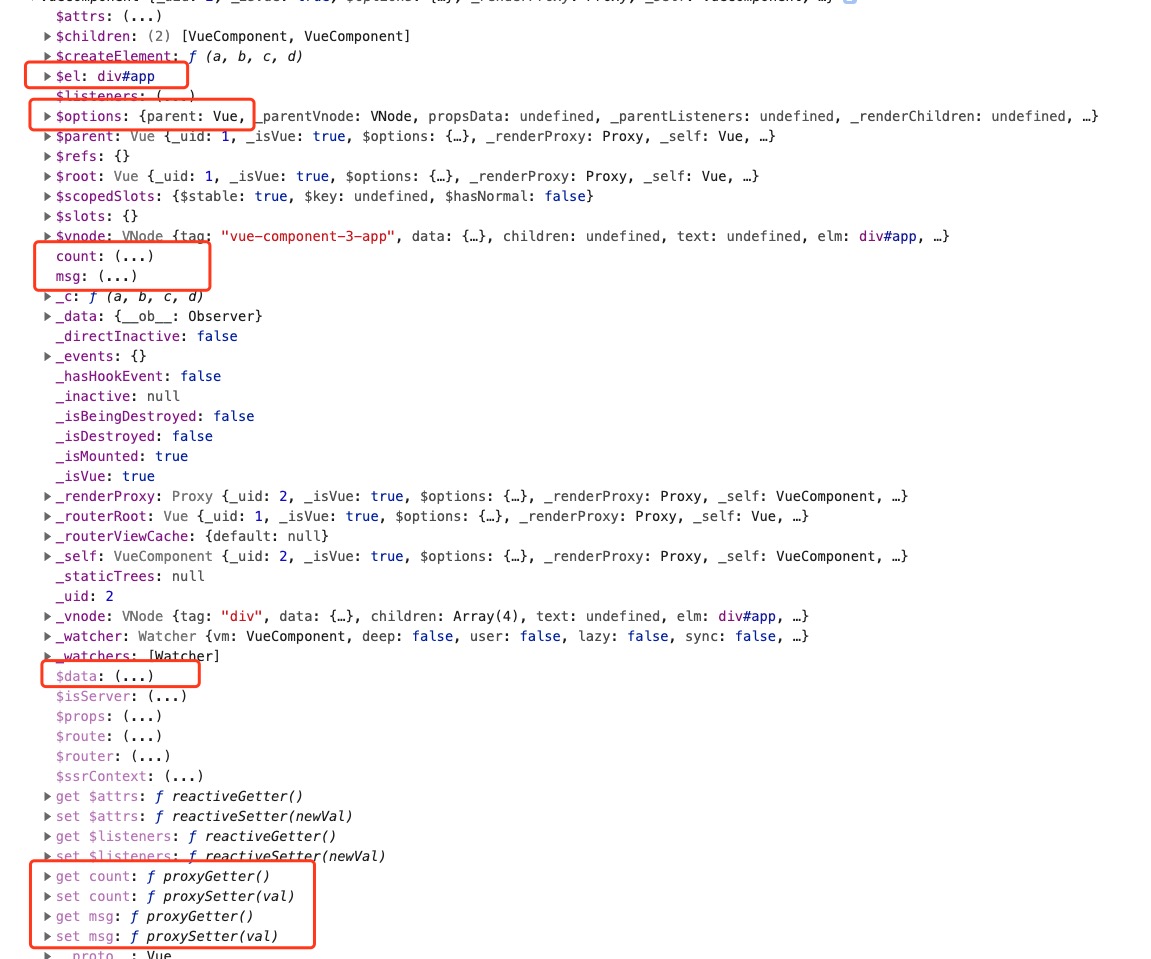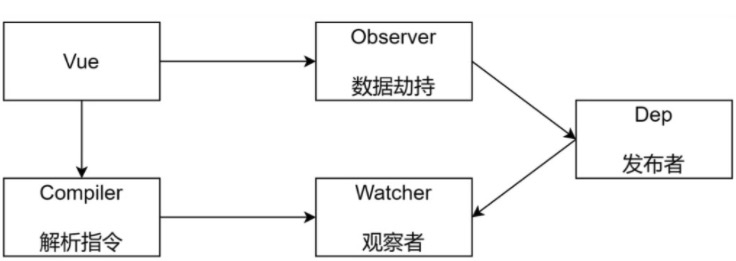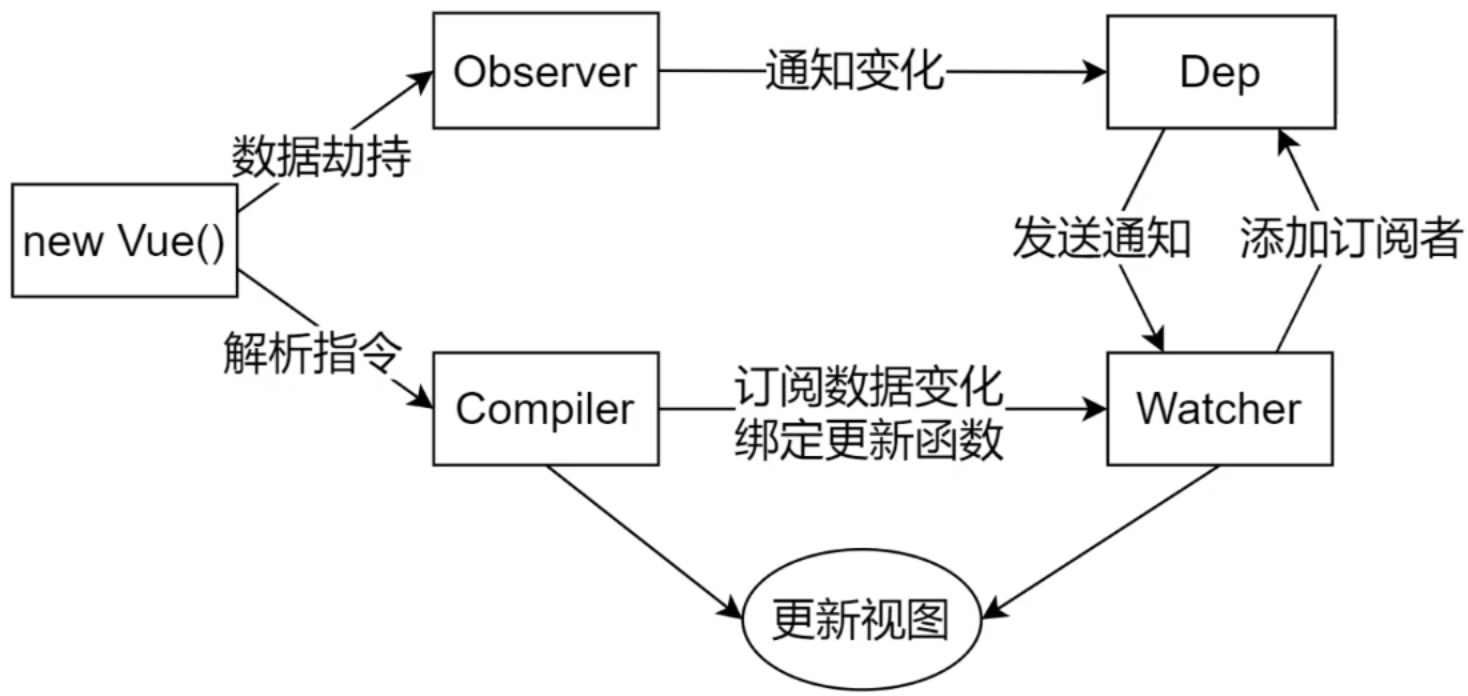# 模拟Vue响应式原理
# 模拟实现的Vue基本结构
我们需要实现Vue如下的结构
...
<body>
<div id="app">
<h1>插值表达式</h1>
<h3>{{ msg }}</h3>
<h3>{{ count }}</h3>
<h1>v-text</h1>
<div v-text="msg"></div>
<h1>v-model</h1>
<input type="text" v-model="msg" />
<input type="text" v-model="count" />
</div>
<!-- 这是我们需要实现的vue.js -->
<script src="vue.js"></script>
<script>
let vm = new Vue({
el: "#app",
data: {
msg: "hello wrold",
count: 100
}
})
</script>
<body>
...
# 观察Vue实例中的属性,并简单模拟实现
 如图所示,vue的实例当中存在很多属性,本文中我们只简单实现红线框出来的内容。
如图所示,vue的实例当中存在很多属性,本文中我们只简单实现红线框出来的内容。
在Vue实例中,vue会把data中的属性转换到实例中,这样做我们就可以使用this.xxx直接访问到该属性。data对象被Vue转成的$data属性,并设置了getter,setter方法,用来数据监听,传入的构造函数option对象转成了$options对象。
# 实现的Vue的整体结构

- Vue的实例
- Observer对象对data中的属性进行数据监听,数据发生变化后会通知Dep
- Compiler是对template中的表达式进行解析,完成数据的转换
- Dep是用来添加Watcher,当数据发生变化时会通知所有的Watcher
- Watcher中的update方法,用于更新View视图
# Vue类
- 负责接收初始化的options参数
- 负责把data中的属性注入到实例中,并转换成getter/setter
- 负责调用observer监听data中所有属性的变化
- 负责调用compiler解析指令/插值表达式,在View视图中绑定数据
class Vue {
constructor(options) {
// 1. 通过属性保存选项的数据
this.$options = options || {}
// 2. 把data中的属性注入到实例中,并转换成getter/setter
this.$data = options.data || {}
this.$el = typeof options.el === 'string' ? document.querySelector(options.el) : options.el
this._proxyData(this.$data)
// 3. 调用observer对象监听数据变化
new Observer(this.$data)
// 4. 调用compiler对象解析指令、插值表达式
new Compiler(this)
}
_proxyData(data) {
// 遍历data中的所有属性
Object.keys(data).forEach(key => {
// 把data中的属性注入到Vue实例中
Object.defineProperty(this, key, {
enumerable: true,
configurable: true,
get() {
return data[key]
},
set(newVal) {
if (data[key] === newVal) {
return
}
data[key] = newVal
}
})
})
}
}
# Observer类
- 负责把data中的属性转成响应式数据
- data中的某个属性也是对象时,需要递归调用把该对象中的所有属性转换成响应式数据
- 当数据发生变化时发送通知
- 内部结构:walk(data)、defineReactive(data, key, value)
class Observer {
constructor(data) {
this.walk(data)
}
// 遍历data所有属性
walk(data) {
// 判断data是否为空值,对象
// 如果是对象,遍历
if (!data || typeof data !== 'object') {
return
}
Object.keys(data).forEach(key => {
this.defineReactive(data, key, data[key])
})
}
// 定义响应式数据, 把data中的数据属性转成响应式数据
// defineReactive为什么要传第3个参数?
// 如果我们将defineReactive中的get方法改成return data[key]时,此时相当于又触发了当前属性的get方法,会造成一个递归循环调用导致堆栈溢出的报错
defineReactive(data, key, value) {
// 保存this指向问题
const self = this
// 如果value是对象,递归调用将value中的属性转成响应式数据
this.walk(value)
// 创建dep对象 收集依赖并发送通知
let dep = new Dep()
Object.defineProperty(data, key, {
enumerable: true,
configurable: true,
get() {
// 当外部有访问属性的动作时
// 此处就形成了一个闭包
// 收集依赖
Dep.target && dep.addSub(Dep.target)
return value
},
set(newVal) {
if (newVal === value) {
return
}
value = newVal
// 当数据被赋值为对象时,也需要递归调用将新数据中的属性转成响应式数据
self.walk(newVal)
// 当数据变化时发送通知
dep.notify()
}
})
}
}
# Compiler类
- 负责编译template模板,解析指令/插值表达式
- 负责页面的首次渲染
- 当数据发生变化后重新渲染View视图
- 内部属性结构:
el、vm、compile(el)、compileElement(node)、compileText(node)、isDirective(attrName)、isTextNode(node)、isElementNode(node)
class Compiler {
constructor(vm) {
this.el = vm.$el
// vue实例
this.vm = vm
this.compile(this.el)
}
// 编译模板 处理文本节点和元素节点
compile(el) {
console.log(el)
if (!el) {
return
}
// 伪数组
let childNodes = el.childNodes
Array.from(childNodes).forEach(node => {
// 处理文本节点
if (this.isTextNode(node)) {
this.compileText(node)
}
// 处理元素节点
if (this.isElementNode(node)) {
this.compileElement(node)
}
// 判断node是否有子节点,如果有需要递归调用compile
if (node.childNodes && node.childNodes.length) {
this.compile(node)
}
})
}
// 编译元素节点处理指令 这里只模拟 v-text v-model
compileElement(node) {
// console.log(node.attributes)
// 遍历所有的属性节点
Array.from(node.attributes).forEach(attr => {
// 判断是否为指令
let attrName = attr.name
if (this.isDirective(attrName)) {
// v-text -> text v-model -> model
attrName = attrName.substr(2)
let key = attr.value
this.update(node, key, attrName)
}
})
}
update(node, key, attrName) {
let updateFn = this[`${attrName}Updater`]
updateFn && updateFn.call(this, node, this.vm[key], key)
}
// 处理v-text
textUpdater(node, value, key) {
node.textContent = value
console.log(this)
// 此处this.vm无法访问, updateFn的this指向问题
new Watcher(this.vm, key, newVal => {
node.textContent = newVal
})
}
// 处理v-model
modelUpdater(node, value, key) {
node.value = value
new Watcher(this.vm, key, newVal => {
node.value = newVal
})
}
// 处理文本节点,插值表达式
compileText(node) {
// console.dir(node)
// {{ msg }} 使用正则来匹配
let reg = /\{\{(.+?)\}\}/
// 文本节点内容
let value = node.textContent
if (reg.test(value)) {
// 属性名
let key = RegExp.$1.trim()
node.textContent = value.replace(reg, this.vm[key])
// 创建Watcher对象,数据变化时更新View视图
new Watcher(this.vm, key, newVal => {
node.textContent = newVal
})
}
}
// 判断元素属性是否是指令 v-xxx
isDirective(attrName) {
return attrName.startsWith('v-')
}
// 判断是否为文本节点 nodeType === 3 文本节点
isTextNode(node) {
return node.nodeType === 3
}
// 判断是否为元素节点 nodeType === 1 元素节点
isElementNode(node) {
return node.nodeType === 1
}
}
# Dep(Dependency)类
- 收集依赖,添加观察者(Watcher),在data的getter中收集依赖,在setter中通知依赖
- 通知所有Watcher
- 内部结构:
subs、addSub(sub)、notify()
class Dep {
constructor() {
// 存储所有的Watcher对象
this.subs = []
}
// 添加Watcher
addSub(sub) {
// 判断sub对象是否为Watcher
if (sub && sub.update) {
this.subs.push(sub)
}
}
// 发送通知
notify() {
this.subs.forEach(sub => {
sub.update()
})
}
}
# Watcher类

- 当数据发生变化时触发依赖,dep通知所有的Watcher实例更新View视图
- 自身实例化的时候往dep对象中添加自己
- 内部结构:
vm、key、callback、update()
class Watcher {
constructor(vm, key, callback) {
this.vm = vm
// data中的属性名 key
this.key = key
// 回调函数负责更新View视图
this.cb = callback
// 把Watcher对象记录到Dep中的target
// 触发get方法,在get中调用addSub
Dep.target = this
// 保存旧值 访问属性就会触发get方法
this.oldVal = this.vm[this.key]
// 最后置空,防止重复触发
Dep.target = null
}
// 当数据发生变化时更新View视图
update() {
let newVal = this.vm[this.key]
if (this.oldVal === newVal) {
return
}
this.cb(newVal)
}
}
# 数据双向绑定
- 当数据发生变化时,View视图也发生变化
- 当View视图变化时,数据也发生变化
表单元素中v-model绑定的值,默认添加input事件,当视图中值发生变化时,通过input事件将更改后的值赋值给实例中的对应属性,当对应属性值发生变化后就会触发数据响应式机制。
在Compiler类中处理v-model指令的函数中添加代码
modelUpdater(node, value, key) {
...
// 双向绑定
node.addEventListener('input', () => {
this.vm[key] = node.value
})
}
# 完整代码
完整的代码见github (opens new window)
# 总结
整体流程

← 虚拟Dom Vue.nextTick原理 →